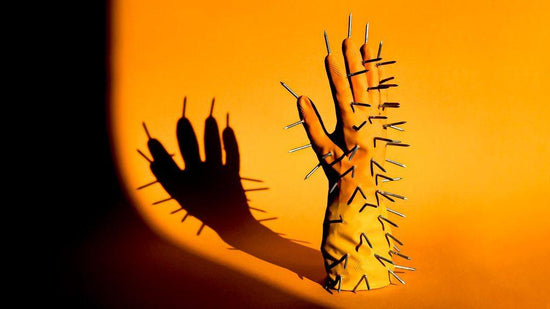Living with kyphosis is my thing: what’s yours?
Featured Articles

Just remember, we can't see pain. We don't all walk around with our pain written across our foreheads, and a perpetual sad face. | Photo ©Victor Koldunov / Adobe Stock
Living with kyphosis is my thing: what’s yours?
What is your thing, do you know? Mine? I have had chronic pain (I hate the word chronic), due to a spine disorder called kyphosis (This is similar to scoliosis – that test we all had to have done in grade school) but instead of being curved sideways, I was hunched over.
Starting at the age of 13, I’ve had two spine fusions and eight surgeries over 27 years to try and fix the kyphosis. I’ve had hardware put in, taken out, put back in, casts, brace, been on opiates for over 8 years at a time, been through every possible array of therapy, and seen every doctor in every specialty. I now have the highest-tech gadget installed in my body (I even have a remote control) to help block pain signals going into my brain! Newsflash: This isn’t going away (Oh yes, see the definition of chronic, that word I love).
I am still living with kyphosis – even if you can’t see it
We all have something; some we can see, some we cannot. All of us will go through something short-term or longer involving pain, such as taking care of a parent or child, cancer, divorce, and depression that will always impede on our work and life balance, and it’s always a struggle to blend these two.
We don’t talk about it, yet I guarantee we all have that “something” that impacts us; we don’t know how to deal with the actual situation, how to admit it to ourselves, let alone our friends and family, and this will without a doubt impact our work.
I also guarantee no one wants to have a conversation with our boss or colleagues on how this is affecting our work, and we aren’t built with the tools to do so, plus fear the consequence of being seen as weaker than our peers. For me, working in a male-dominated industry where typically 90% of the people in the room were men, the last thing on earth I wanted was to expose any vulnerability!
Gosh Kate, I didn’t know you were living with Kyphosis
During my sabbatical, I realized this was the opportune time to understand how dealing with daily pain impacts my work. I also realized I needed to put this a bit more into the forefront of my priorities. Not just a bit, but a lot more. I need to know what to do when chronic pain is unbearable.
I’ve always prided myself on hiding kyphosis, as well as hiding physical pain from others. People would say to me, “Gosh Kate, I didn’t know you had any spine problems,” and to me, that was winning! That fed into itself and kept the habit of not speaking about it for years. To me, this was my strength, when it is quite the opposite. This helps NO ONE. Faced with time, I enrolled in a pain psychology program that worked on both the physical and mental aspects over 3 weeks with 10 others. Let’s dive into this head-on and be open, vulnerable, and learn. What’s the worst that could happen?
Ten reflections about living with kyphosis, pain and my life
I’m six months post-pain psychology program and currently in the middle of a kyphosis flare-up, so let me reflect on what I’ve learned about pain, my life and living with kyphosis.
Demographics – EVERYONE is going through or will go through something painful.
The community built during this programme was the biggest asset – we need a safe zone. During bad back days, I build a cocoon around myself, both physically and figuratively.
I am piss poor at communicating my needs to my friends, family, partners, and most of all colleagues – I’m fine, I’m fine…nothing to see here, folks!
I need to create a “Kate Handbook” for friends, family, partners, and colleagues on how to support me (Advice from my fabulous physio Warrick McNeil).
Having pain is hugely isolating and lonely – It’s taken me 27 years to say this line. Let’s say that again, my kyphosis back pain is hugely isolating and makes me feel very lonely.
I’m lucky that this started at the age of 13, I don’t know any different, and it’s been ingrained in my life.
I realized I was the anomaly in our group and don’t fear the pain on a day-to-day basis, pretty much ignore it but DO fear what it will do to my personality in the long term – I don’t like being grumpy.
If I tell you I have back problems OR show you a photo of my X-ray – the response is drastically different.
My spine is my biggest asset – it’s built many of the characteristics that make up Kate (strength, determination, leadership, patience, persistence).
Living with Kyphosis means I shouldn’t store my pain in a box
I have had the great fortune of jobs that enable me to travel, working with some of the most interesting people across the globe which provided me the energy and adrenalin.
What I realized I would do is Go Go Go, the adrenalin moving me forward from meeting to meeting, flight to flight, and then I would walk through my door at home, and my body would completely shut down. I didn’t want to move, or speak and would move into cocoon mode. The human body is just brilliant! How does it let me store my pain in this little box in my body and then know when to open that box and shut my body down? Clearly, this isn’t a healthy practice for me or anyone around me.
Now, I’m working on the practice of building in moments each day for me to physically stop. My colleagues who have children would take a break between meetings and dinners to call home and chat with the family. This was my “calling home.” Sit still, breathe, and take stock of my body and how I am feeling. Using mindful tools and breathing exercises, as well as actually naming my pain.
Talk to it, acknowledge it, and sometimes throw a few cuss words at it; it’s okay. Don’t let that box of pain fill up, but open it a bit every day. In addition, creating a list of my “non-negotiables” as I look to the next career path (e.g., I need business class for long-haul flights if you want me to be able to walk and be my productive self!). Drawing up my very own Do Not Do list was essential.
The second aspect that surprised me, and I use more now, is showing people my spine versus saying I have back problems. This also makes me think deeper about those who have chronic illnesses such as depression that are not visible to the eye and how difficult it is. It is easy to forget that not all disabilities are visible.
Conversations with me went from “I have a long series of back problems” and the response being “Yes, I know what you feel; I slipped a disc last year, and it was horrible” to me showing a photo of my Xray, and the response went to “Holy shit, you’re a robot, how on Earth do you smile all the time?” A picture IS worth a thousand words or, a thousand expressions.
How can we ensure empathy and understanding for those who don’t have a picture or visual?

From a broader perspective, those living with kyphosis or dealing with any other chronic health issue experience the following:
- We hate to be seen as complainers and feel like a burden to friends and family.
- How to respond or support is difficult to articulate – URevolution's Diversity Inclusion Disability magazine is a brilliant platform to bring these discussions to light (e.g., please don’t send me flowers in the hospital – I’m nauseous after anesthesia, and the smell makes me vomit. Thank you.)
- We will laugh at the most bizarre things that only make sense to us – Laughter helps everything, right, Mom?
- If I say I’m having a bad back day, the best question is, “What does it feel like?”
- We don’t need your advice (I know this is not easy to hear), but will ask you when we do need it!
- I/We are no less productive, innovative, or skilled than others; in fact, probably more so due to the adversity we’ve faced.
Pain is inevitable – One of the most important Questions in Life – How Much Pain are you Willing to Endure?
Pain builds our character and leads us; we all have it. Let’s grasp it, acknowledge it, dive into it, and be more open and empathetic. Painful situations build the skills that help us in our careers!
Building the community and the ability to speak about this will build strong teams, bonds between colleagues, and happier employees when flexible practices are put into place.
When you’re sitting at the next meeting, and your colleague may seem to be in a bad mood, just remember, we can’t see if they are pain.
What is your thing?
Living with kyphosis is mine.
"When you’re sitting at the next meeting, and your colleague may seem to be in a bad mood, just remember, we can’t see if they are pain."

Kate Krukiel
Kate Krukiel, author of "Living with kyphosis is my thing," is currently on a work sabbatical after spending 20 years in the private sector, the last 12 working with international organizations in building strategic partnerships to promote sustainable social and economic growth.


















